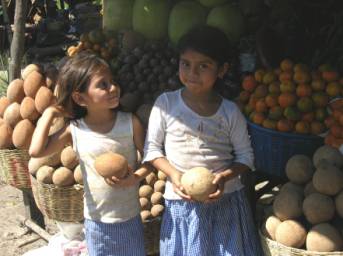From Fairchild Tropical Botanic Garden
by Noris Ledesma, Curator of Tropical fruit
The Tropical Apricot in South Florida

The tropical apricot (Mammea americana)
is one of the best kept tropical fruit secrets of Tropical America. No
relation to the true temperate apricot of the northern climes, this
fruit is a bit of a challenge, but worth the effort. A handsome
evergreen, it resembles a southern magnolia at first glance and
naturally forms a pyramidal, pleasing canopy. The tree is densely
foliaged with glossy, leathery leaves of hunter green. The tree is a
great asset in the home landscape that will provide a point of pride
among your neighbors. Native to the West Indies and northern South
America, the tree produces large, round brown fruit, with a deep orange
flesh.
The flesh is highly fragrant with a flavor of apricot and
berries and can be eaten fresh or used to prepare jellies, preserves,
or sherbets. The fruit is eaten while the flesh is still firm and the
fruit will maintain their attractive flesh color for hours or even
days. A cut fruit can be left on the kitchen counter and it will not
brown. Now try that with apple or with the temperate apricot.
Origin.
On the island of Hispaniola, which is home to Haiti and the Dominican
Republic, the tree and fruit are highly esteemed. Towering walls of
green grace the home gardens across the island, lending a true
Caribbean flavor wherever its shade touches. The flowers are used in
preparing the liqueur Eau de Créole, another signature flavor of
the islands. In Jamaica fruit are cooked with wine and sugar and served
as a warm and cold dessert. Here at home the fruit has the perfect
consistency for pies, tarts and preserves. But, perhaps the best use of
the fruit is fresh out of hand like the people of Central America and
northern South America.
Propagation.
Propagation of the tropical apricot for the home garden is typically
from seed. The tree is not commonly found in nurseries here in South
Florida, but with a bit of perseverance one can locate and purchase a
healthy tree. The next hurdle is that the tree comes in a male and
female version. This may sound romantic, but it makes the growing of a
seedling a risky business. It can be quite a blow to wait for eight
years or so only to find out that your tree is a male and will produce
no fruit. The tree itself is no less attractive in the home landscape,
but it will not produce fruit.
The best solution is to grow a
grafted tree. Specialty nurseries in South Florida are beginning to
propagate known female selections and these trees are becoming more
common fare about town. At present the varieties ‘Redlands’
and ‘Kay Sweeney’ can be purchased on a routine basis. In
the next few years there will be more quality selections coming
available from local hobbyists and the Fairchild Tropical Botanic
Garden. A quality grafted tree will fruit even in isolation, although a
male tree in close proximity may improve yields. A grafted tree will
begin to flower and fruit in three to five years after planting.
Where to Grow.
The tropical apricot grows best in a fertile, well drained soil with
high organic matter content, but will tolerate heavy, poor, acid or
alkaline soils. The tree should be planted in the full sun and one
should also plant in the warmest locations. Young trees will be killed
by temperatures below 30F for only a few hours. Young trees will prefer
regular applications of water, but mature trees can do quite nicely
with no watering. The tree will thrive in our monsoon climate,
remaining green and healthy throughout the drought months. Cold
sensitivilty is probably the most serious limitation to the
establishment and young trees should be protected on the coldest nights
of the winter. Small trees can be covered by a sheet or with a
cardboard box, taking care to not let the leaves touch the sheet.
Fertilizer.
Addition of plant mulch to the soil surface will improve water-holding
capacity, nutrient retention and availability and soil structure.
Fertilization is best done by three applications per year in March,
July and September with an 8-3-9 or other fruit tree formulation. Do
not fertilize after September, as you will make the tree more
susceptible to cold damage. You must go into the winter months with the
tree calm and prepared for cold.
Harvest.
In southern Florida the tropical apricot ripen from late mostly in the
summer and fall and they fall to the ground when ripe. They can also be
picked when they reach full size and show an external color change from
greenish to orange brown, but this will take some practice to master.
The tropical apricot is a tree well worth the home owner’s
investment of time and worry. With just a little care, the tree will
reward the gardener with a beautiful landscape and delicious fare for
the summer table.
Back to
Mammey Apple Page
|
|